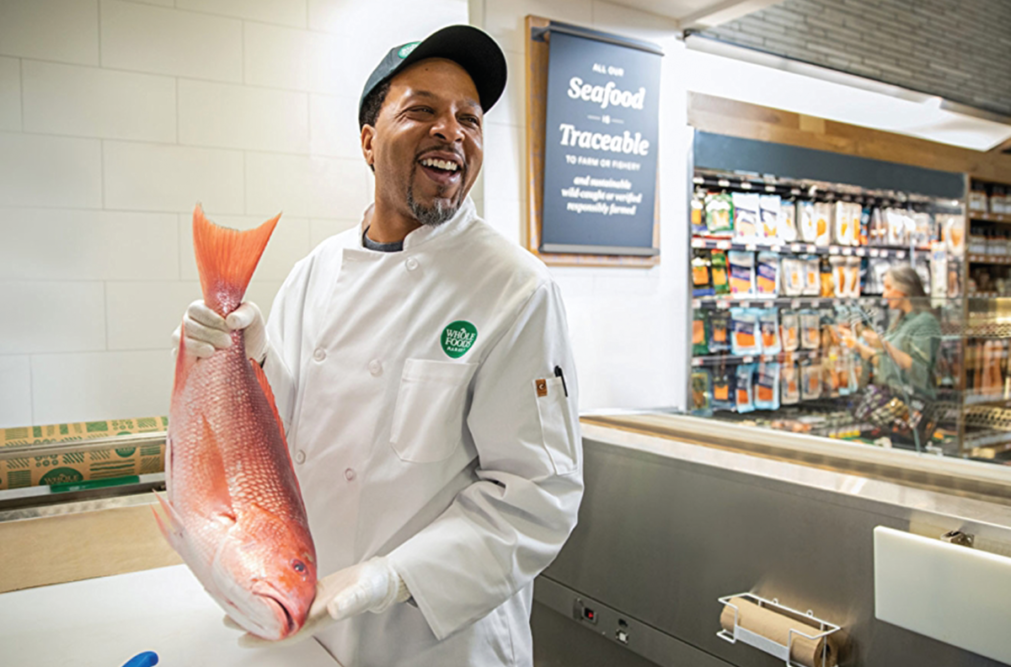Transparency and sustainable sourcing — particularly in the fresh seafood arena — have become paramount to shoppers.
A majority (72%) of shoppers say transparency is “extremely important” or “important,” according to FMI - The Food Industry Association and Nielsen IQ’s Transparency in an Evolving Omnichannel World report. Plus, 64% of shoppers say they would switch from a brand they usually buy to another brand that provides more in-depth product information, beyond nutrition facts.
More than half of frequent seafood consumers said sustainability has an impact on their shopping habits, according to FMI’s 2021 “Power of Seafood” report.
Importantly, nearly half of consumers surveyed by Retail Insight said they would “be happy paying a premium” for products that are “green”, and 52% said they would be happy for their weekly grocery bill to go higher if it meant helping the environment.
“It’s now more important than ever that grocers’ sustainability initiatives go beyond the rhetoric,” said Paul Boyle, CEO of Retail Insight. “This isn’t just impacting sales, it’s redefining customer loyalty; our research shows that 55% of shoppers would be more loyal to a grocery store brand if they perceived the business to be green.”
And an Elementar UK survey found that 84% of consumers check where their food has come from either all, most, or some of the time. It also found that 66% are either very or quite concerned about where their food has come from, and 68% said that the origin of food is either very or quite important in influencing purchasing decisions.
“Consumers want to be more knowledgeable about the quality of their seafood, where it comes from and what to look for when buying,” said Jennifer Barrett, vice president of sales at Del Pacifico Seafoods, a longtime supplier of sustainable wild Mexican blue shrimp that recently added Aquaculture Stewardship Council-certified farmed white (vannamei) shrimp to its lineup.
“The majority of seafood consumers will associate quality with freshness so it’s important to be able to set yourself apart and help consumers make informed choices,” Barrett added.
Chains step up their games
Many major grocery chains have made significant advances their sustainability and transparency initiatives. Often, partnerships with suppliers and organizations such as the Norwegian Seafood Council are the key to the programs’ success.
Whole Foods Market was one of the first to focus on traceability and sustainability with programs such as its strict Farm-Raised Seafood Standard. One of the notable provisions in WFM’s standard is that suppliers must utilize Whole Foods Market-selected electronic traceability software to allow the retailer to verify sourcing of all seafood products and to track products.
“Their rigorous standards help maintain healthy fish populations, protect ecosystems and build a more sustainable seafood supply,” said Jennifer Bushman, strategic development officer for Kvarøy Arctic. Kvarøy supplies Fair Trade-certified, sustainable salmon raised in ocean net pens off the coast of Norway, to WFM, Giant Eagle, and other grocers.
“They have their own Whole Foods Seafood Certification which we helped to originate in salmon and exceed to this day,” Bushman added.
Among the provisions in WFM’s Farm-Raised Seafood Standard is the requirement that producers own leases for their farm sites and not use preservatives, antibiotics or chemicals in the fish production. Genetically modified or cloned fish are also not allowed.
“Our salmon must be raised in carefully monitored, low-density pens and tanks without antibiotics, synthetic pesticides or added growth hormones,” Bushman said. “Detailed protocols that are audited regularly prevent escape of the salmon into the wild, and harmful and lethal methods are never used on predator birds and marine mammals. Also, our color must be naturally derived and have to be from non-synthetic sources,” Bushman said.
To have traceability and sustainability in aquaculture, “a lot of the answer lies in fish feed,” said Anne-Kristine Øen, director, USA, for the Norwegian Seafood Council.
“If you want to produce seafood in the most sustainable manner, it is of course vital that every ingredient that goes into the fish feed is well documented and can be traced. This is something that the salmon industry in Norway has focused on for a long time,” Øen said.
QR codes on seafood packages help consumers see the traceability of each seafood product themselves, Øen and other experts noted. This year, the NSC will step up its use of QR codes, allowing shoppers to trace the origin of the fish, read stories of the fishermen/women who raised the fish, and find recipes and tips on the best ways to cook the fish.
“Providing easy-to-follow recipes will make customers more at ease and confident when heading to the seafood counter,” Øen said. Plus, the origin of seafood matters to an increasing amount of customers, she noted.
Origin labeling and eco-labeling are “great ways to effectively communicate with your customers,” Øen said.
“For most people, having a smartphone in our pocket allows us to more frequently use QR codes — one of the best methods for supplying a constant stream of new ideas and unlimited amounts of seafood knowledge at the tip of your fingers,” Øen explained. “By having a QR code stamped on every seafood package or on a safety seal on a takeaway dish, we can speak to the people and track what information is getting the most traction and make sure the information keeps coming.”

